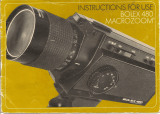
Depth of Field
Depth of field refers to the zone of acceptable
focus extending in front of and behind the
plane of sharpest focus. As this zone is excep-
tionally shallow at high reproduction ratios,
previewing is desirable before shooting. To
preview, press the depth-of-field button on
the camera and the lens will close to the
preselected aperture to allow you to see how
much background and foreground is in focus.
Depth of field can also be observed by reading
the color-coded indicators inscribed on the
lens barrel. The pairs of colored lines on either
side of the white distance scale index line
correspond to f/numbers of the same color on
the aperture scale. At close distances, so little
is in focus that the depth-of-field tables on
pages 13 ~ 14 are more useful.
NOTES ON FOCUSING
Camera Shake: Close-up photography poses
several problems not encountered in general
photography. One of these is sensitivity to
vibration—the magnification of the image is so
high that even slight displacement during
shooting results in a blurred image. Therefore,
the use of a tripod is recommended at all
times,
with shutter actuated via cable release.
In this respect, the convenient, 360° rotatable
tripod mounting collar on the PN ring will
prove useful.
Close Working Distances: At high reproduction
ratios encountered during close-up shooting,
depth of field decreases drastically. This
con-
dition can be partially compensated for by
stopping down the lens. But at very close
working distances, an extremely shallow depth
of field is inevitable. Careful placement of the
camera will be necessary to ensure that the
important surfaces of the subject are in the
same zone of sharpness.
9


















